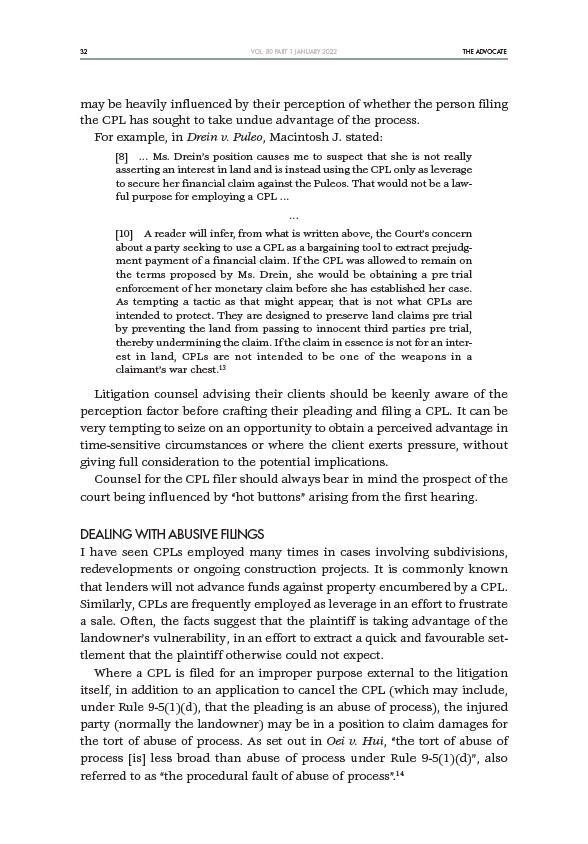
32 THE ADVOCATE
VOL. 80 PART 1 JANUARY 2022
may be heavily influenced by their perception of whether the person filing
the CPL has sought to take undue advantage of the process.
For example, in Drein v. Puleo, Macintosh J. stated:
8 … Ms. Drein’s position causes me to suspect that she is not really
asserting an interest in land and is instead using the CPL only as leverage
to secure her financial claim against the Puleos. That would not be a lawful
purpose for employing a CPL …
…
10 A reader will infer, from what is written above, the Court’s concern
about a party seeking to use a CPL as a bargaining tool to extract prejudgment
payment of a financial claim. If the CPL was allowed to remain on
the terms proposed by Ms. Drein, she would be obtaining a pre trial
enforcement of her monetary claim before she has established her case.
As tempting a tactic as that might appear, that is not what CPLs are
intended to protect. They are designed to preserve land claims pre trial
by preventing the land from passing to innocent third parties pre trial,
thereby undermining the claim. If the claim in essence is not for an interest
in land, CPLs are not intended to be one of the weapons in a
claimant’s war chest.13
Litigation counsel advising their clients should be keenly aware of the
perception factor before crafting their pleading and filing a CPL. It can be
very tempting to seize on an opportunity to obtain a perceived advantage in
time-sensitive circumstances or where the client exerts pressure, without
giving full consideration to the potential implications.
Counsel for the CPL filer should always bear in mind the prospect of the
court being influenced by “hot buttons” arising from the first hearing.
DEALING WITH ABUSIVE FILINGS
I have seen CPLs employed many times in cases involving subdivisions,
redevelopments or ongoing construction projects. It is commonly known
that lenders will not advance funds against property encumbered by a CPL.
Similarly, CPLs are frequently employed as leverage in an effort to frustrate
a sale. Often, the facts suggest that the plaintiff is taking advantage of the
landowner’s vulnerability, in an effort to extract a quick and favourable settlement
that the plaintiff otherwise could not expect.
Where a CPL is filed for an improper purpose external to the litigation
itself, in addition to an application to cancel the CPL (which may include,
under Rule 9-5(1)(d), that the pleading is an abuse of process), the injured
party (normally the landowner) may be in a position to claim damages for
the tort of abuse of process. As set out in Oei v. Hui, “the tort of abuse of
process is less broad than abuse of process under Rule 9-5(1)(d)”, also
referred to as “the procedural fault of abuse of process”.14